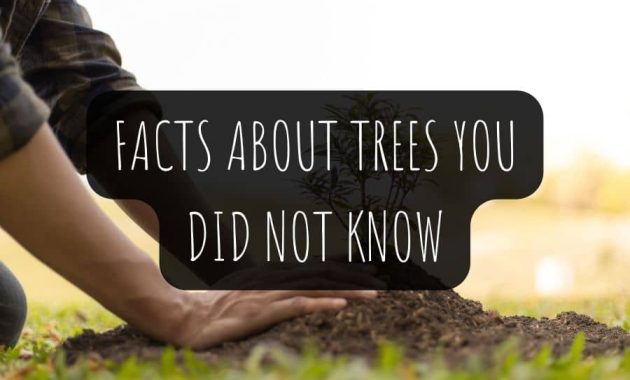50 Facts About Trees You Did Not Know
Discover fascinating and lesser-known facts about trees that will amaze you and deepen your appreciation for these vital, living organisms.
Trees have always played an essential role in our lives, providing us with oxygen, shade, and resources. But there's more to these towering organisms than meets the eye.
In this post, we'll explore some lesser-known and intriguing facts about trees that will leave you with a newfound appreciation for these incredible wonders of nature.
From their ability to communicate with one another to their surprising impact on climate, prepare to be amazed by the hidden world of trees.
See also: Arbor Day Trivia
Table of Contents
Tree Facts For Kids

- Trees are plants that have a woody stem called a trunk, which supports their branches and leaves.
- Trees provide oxygen for us to breathe by taking in carbon dioxide and releasing oxygen through a process called photosynthesis.
- Some trees are considered "keystone species" due to their disproportionately large impact on their ecosystem.
- The most common tree species in the United States is the red maple (Acer rubrum).
- Tree planting initiatives, such as reforestation projects, aim to combat deforestation and restore ecosystems.
- Trees can help keep our environment clean by filtering pollution from the air and absorbing harmful gases.
- Tree rings can tell us how old a tree is and what the climate was like during its lifetime.
- The study of trees is called dendrology, a branch of the broader field of botany.
- Trees can act as natural noise barriers, reducing noise pollution.
- Trees play a crucial role in the water cycle, releasing water vapor into the atmosphere through a process called transpiration.
Facts About Trees
- Trees are the largest and longest living organisms on Earth.
- There are over 60,000 different species of trees worldwide.
- Trees can live for thousands of years; the oldest known tree is a bristlecone pine named Methuselah, estimated to be over 4,800 years old.
- Tree height can vary dramatically, from a few feet to over 300 feet tall.
- The tallest tree species is the coast redwood (Sequoia sempervirens), which can reach over 380 feet in height.
- Trees can communicate with each other using chemical signals and underground fungal networks called mycorrhizae.
- Trees improve air quality by filtering pollutants and absorbing harmful gases.
- Trees provide habitat and food for countless animal species, including birds, insects, and mammals.
- Forests cover approximately 31% of Earth's total land area.
- The largest type of tree by volume is the giant sequoia (Sequoiadendron giganteum).
- Trees can help mitigate climate change by absorbing and storing carbon dioxide in their wood, leaves, and roots.
- The process of shedding leaves in deciduous trees is called abscission.
- Trees can provide natural shade and reduce energy consumption in buildings.
- Some trees have deep taproots that can access water sources far below the soil surface.
- The process of tree growth occurs in the cambium, a layer of cells between the bark and wood.
- Tree's age, as well as provide information about past climate conditions and environmental changes.
- Trees can reproduce both sexually, through seeds, and asexually, through vegetative propagation.
- The largest single living organism by mass is a quaking aspen (Populus tremuloides) grove called Pando in Utah, which is considered one tree due to its interconnected root system.
- The world's most massive single-stemmed tree is the General Sherman, a giant sequoia with a volume of over 52,500 cubic feet.
- There are two main types of trees: deciduous trees, which lose their leaves in the fall, and evergreen trees, which keep their leaves all year round.
Important Facts About Trees
- Some trees have developed unique adaptations to thrive in challenging environments, such as the mangrove trees, which can survive in salty water.
- Fruit-bearing trees provide essential food sources for both humans and wildlife.
- Trees can help reduce soil erosion by stabilizing slopes and riverbanks with their extensive root systems.
- Tree leaves can change color in autumn due to changes in chlorophyll, carotenoids, and anthocyanin pigments.
- The process of planting new trees is called afforestation, while reforestation refers to the replanting of trees in areas where they have been previously removed.
- Some tree species have medicinal properties and have been used for centuries in traditional medicine.
- Trees can be used as natural windbreaks, protecting crops and soil from erosion.
- Tree bark can have various functions, such as protecting the tree from fire, insects, and diseases.
- The world's most massive known tree stump, known as the "Tjikko Stump," belongs to an ancient clonal Norway spruce in Sweden and is over 9,550 years old.
- Trees can increase property values by adding beauty and curb appeal.
- Some trees, such as the baobab, store large amounts of water in their trunks to survive drought conditions.
- Many trees have cultural and spiritual significance in various societies and religions.
- Trees can be used as a renewable energy source, such as in the production of wood pellets for heating and biomass for electricity.
- The world's oldest tree nursery is located in Egypt and dates back to around 1500 BCE.
- Trees can help cool urban areas, reducing the urban heat island effect.
- The process of removing trees is called deforestation, which can lead to habitat loss, soil degradation, and climate change.
- The world's largest contiguous forest, the boreal forest, stretches across North America, Europe, and Asia.
- The Amazon rainforest is home to the highest concentration of tree species globally, with estimates of over 16,000 species.
- The largest tree by girth (circumference) is the Montezuma cypress (Taxodium mucronatum) in Mexico, known as El Árbol del Tule.
- The largest forest by area is the Taiga, also known as the boreal forest, stretching across Russia, Canada, and parts of Scandinavia.


Related Posts